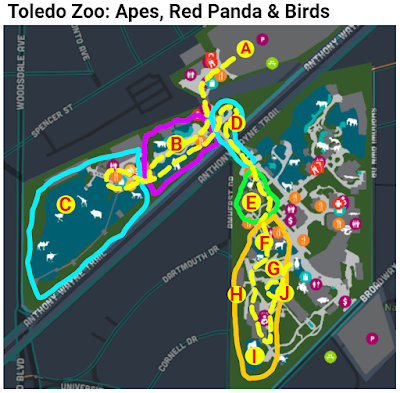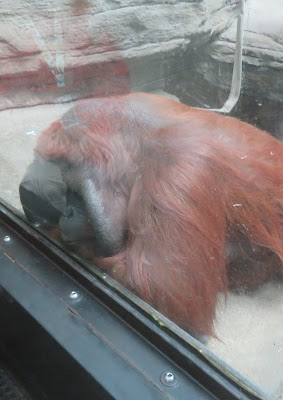The lighting and mesh of the habitats perimeter made getting a good pic of the Gibbon impossible and the little Red Panda was not in a photogenic mood!--curled up in a ball way up high napping. But the Guenon's were more than happen to fill in, and unlike the other two habitats, theirs came with a plexi-glass viewing opportunity.
On the far side was a children's play area--with a Blue Crab statue (G)! Loved it. For those by-passing the fun, and large long habitat (H) with Cinereous Vultures (Aegypius monachus) a species completely new to me and one that the Toledo Zoo has some success breeding as part of an AZA SSP (Species Survival program) and Hadada Ibis (Bostrychia hagedash) led you on to the Great Apes.
The Toledo Zoo is home to both Bornean Orangutans (Pongo pygmaeus) and Western Lowland Gorillas (Gorilla gorilla). A large complex of interior and exterior habitats called the Kingdom of the Apes (I) is their home. All of the apes were inside and in multi-story interior habitats outfitted with climbing aparatus and for the Orangutans, nesting hammocks. It was here that I encountered a keeper who was answering questions for visitors. It didn't appear to be part of any advertised Keeper Chat. She was pleasant, but new to the zoo and didn't have a lot of background information to share. In the adjoining habitat was one of the Bornean Orangutan families. The zoo is who to two. Both couples have one offspring. Today, the male, Boomer, was resting against the glass while the adult female, Yasmin, was swinging around him, blowing kisses to the Keeper, and foraging from chunks of veggies and fruit left out for them to find. Their male offspring, Wakil (age 8) was ducking in and out of the open entrance to the private space.
The other Orangutan family and members of the Gorilla troop were out and active in similar habitats in other areas of the building. We emerged on the same side of the building we entered, and because the options were unclear completely missed the Zeim Conservatory. Given the time and even assuming that it was open, this wasn't necessarily a bad thing! Instead we strolled around the Pheasanty (J), a round structure with about 10 exterior habitats all filled with different species of exotic pheasants and other larger birds like Laughing Kookaburra (Dacelo novaeguineae). From there, a late lunch break.
A group of Primates preparing to enter the Primate Forest
The Gibbon habitat to the right and the Guenons' directly ahead and to the left
Red-tailed Guenon
Cercopithecus ascanius
They have such long tails, but being old world monkeys, they are not prehensile. They cannot use them to climb or hand upside-down, only to balance themselves as they jump from limb to limb.
Children's Playground
Detail of Blue Crab
Bornean Orangutan
Pongo pygmaeus
Bommerang "Boomer" alpha male of group II
Yasmin
Both groups of Orangutans. Fajar, in group I, is the newest addition.














No comments:
Post a Comment